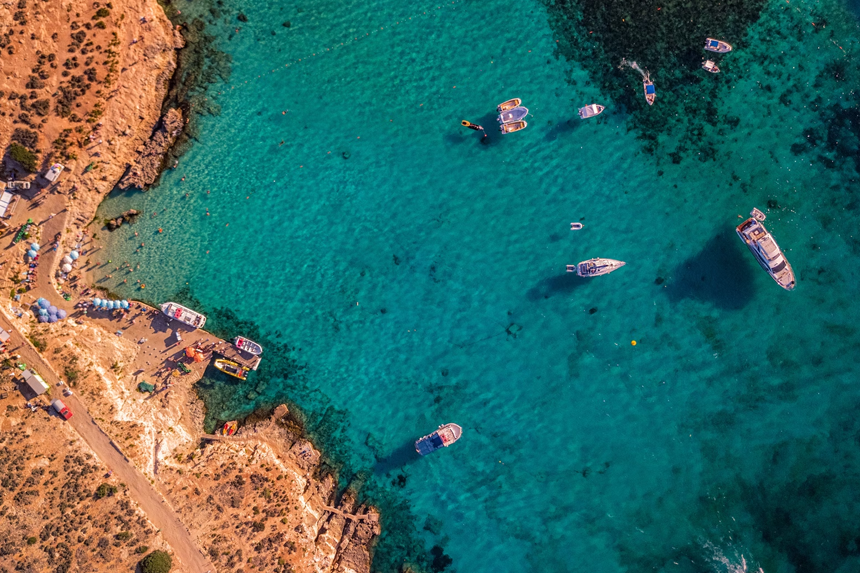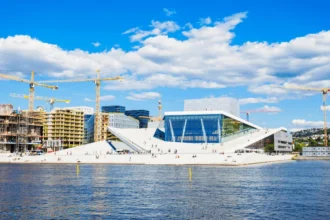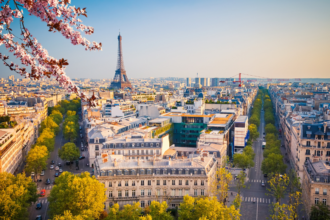Sitting in a café in Marfa Bay, Malta, a resident gazes out at the tiny landmass on the horizon: the 3km-by-5km islet of Comino, a sun-baked rock surrounded by a shimmering sea that shifts from deep blue to bright turquoise. Today, once a near-empty haven, it is one of the most contested tourist destinations in the Maltese archipelago. Comino tourism has increased in recent years, attracting thousands of visitors eager to see its iconic Blue Lagoon.
Luring tens of thousands of people annually from throughout the globe, Comino’s Blue Lagoon is a photographer’s dream and one of the Mediterranean’s most renowned attractions. The bay’s brilliant hue, generated by sunshine reflecting off the white limestone seabed, sparkles under the Mediterranean sun, giving it a wonderful subject for spectacular images. However, its beauty has also led to its downfall. Comino tourism continues to rise, increasing worries about its sustainability and environmental damage.
What Happens to Comino in the Peak Season?
In the December to February low season, the bay’s waters are barely disturbed except for the faint wave of a landing bird. The shoreline is silent, the coastline untouched. But summer tells a different story. Shoulder-to-shoulder people battle for space, rubbish overflows from overflowing bins, and tangles in crushed rock rose shrubs while gas-guzzling powerboats blast music and leave behind a trail of environmental harm. Vendors aggressively compete for customers, and Comino’s tranquil atmosphere is completely transformed.
One long-time visitor recalls, “I first visited in 1980. Back then, you could have the whole place to yourself. Unfortunately, I’ve seen first-hand the destruction over the decades. I don’t know why people bother anymore.” Comino tourism has transformed from a peaceful retreat into an overwhelming experience for many visitors.
Furthermore, the effect on the surroundings is serious. Marine life has suffered due to boat pollution, and native flora struggles under the weight of human foot traffic. Conservationists worry that the island’s fragile ecosystem might suffer irreversible damage unless prompt action is taken.
Is Comino’s Tourism Industry a ‘Scam’?
Frustration over Comino’s overtourism has been growing for years, with some disillusioned visitors even calling the day-trip experience from Malta a “scam.” Overcrowded boats, poor amenities, and rising environmental deterioration have pressured authorities to act.
Seasoned tour guides have heard similar complaints from tourists: “They travel to Comino expecting paradise and leave dissatisfied, crowded, and disorganized. Hopefully, the cap on visitors will make a real difference.”
Beyond overcrowding, visitors often find that the limited infrastructure struggles to accommodate the surge of people. Few facilities, such as shaded areas, food stands, and restrooms, are available, making a day trip to the island less pleasant than ideal.
How Are Activists and Authorities Responding?
Campaigners have stepped in in reaction to the growing scenario. Protesting what they perceived as the exploitation of public space for commercial profit, a local group called Movimenti Graffiti took matters into their own hands in 2022 by stripping the island of its deckchairs and sunbeds. Their message was clear: Comino should be protected, not plundered.
Authorities have also paid attention. This year, to curb mass tourism and relieve pressure on the islet, a designated Natura 2000 site, Maltese authorities are introducing a daily visitor cap – reducing the number of tour boat day-trippers from 10,000 to 5,000.
A tourism official explained, “It’s at the top of many visitors’ bucket lists when they come to the Maltese islands. Many people want to go straight there. But we need to find a balance.” The purpose is to ensure that Comino tourism does not lead to lasting damage.
While this is a welcome step, residents and environmental groups argue it may not be enough. “The cap is necessary but only part of the solution. We need greater investment in sustainable tourism techniques,” claims an environmental advocate. Suggestions include improved trash management systems, eco-friendly transport options, and stricter rules on vendors and boat operators.
Is a Visitor Cap Enough to Save Comino?
Environmental advocates believe that while limiting numbers is a step in the right direction, more action is needed. One conservationist observed, “Limiting populations is a good start. However, we need a public sustainability plan that doesn’t just focus on crowd control but also on preserving Comino’s fragile ecosystem. We insist it should have a ticket control system where only a capped number of tickets can be issued daily.”
Comino’s challenges are not exceptional. Across the Mediterranean, governments are tightening regulations to combat overtourism. Venice has introduced entry fees for day-trippers, while Athens has capped daily visitor numbers to the Acropolis. These shifts signal a broader push toward more sustainable travel.
Experts suggest that Comino could benefit from lessons learned in other destinations. A reservation system could be implemented to control the flow of visitors. At the same time, local authorities could invest in eco-tourism initiatives such as guided nature walks and educational programs on the island’s biodiversity. Restricting motorized boats and encouraging electric or solar-powered alternatives could also help minimize pollution.
Will Comino ever have the same appeal?
With the new laws in place, the goal is for Comino to recapture some of its lost beauty, giving a more enjoyable experience while conserving its ecosystem. But some feel the damage is already done.
“With so many people wearing it down year after year, I just hope there’s something left for future generations to enjoy,” one guide remarked.
Local businesses that rely on Comino tourism are also facing uncertainty. While the visitor cap aims to create a better balance, some boat operators worry about the impact on their livelihood. A boat operator who has been organizing trips to Comino for more than two decades notes, “We understand the need for sustainability, but we also need support to transition into a new model of tourism.”
The battle for Comino’s future has begun. Whether these changes will be enough remains to be seen. One thing is clear: without proper planning and enforcement, the tiny island risks losing its natural beauty and reputation as a paradise getaway. Today’s issue is finding a method to allow people to experience Comino without harming what makes it remarkable.








